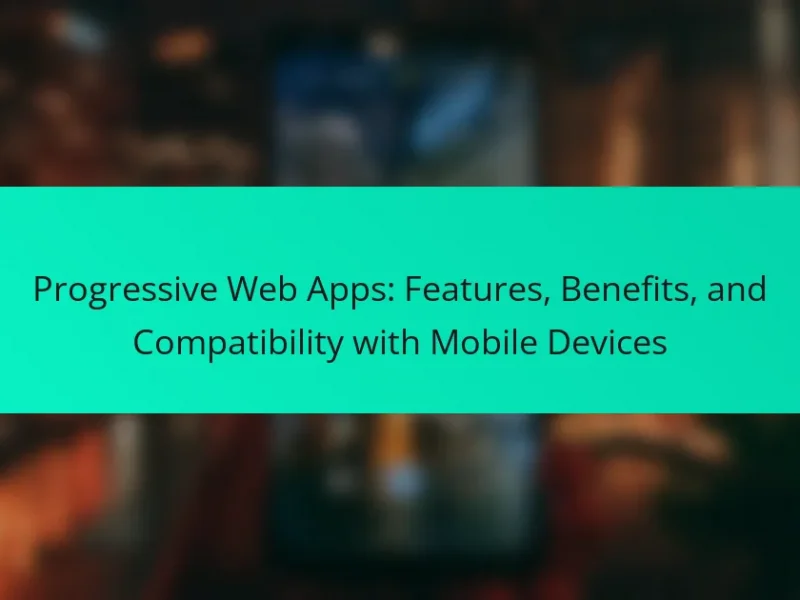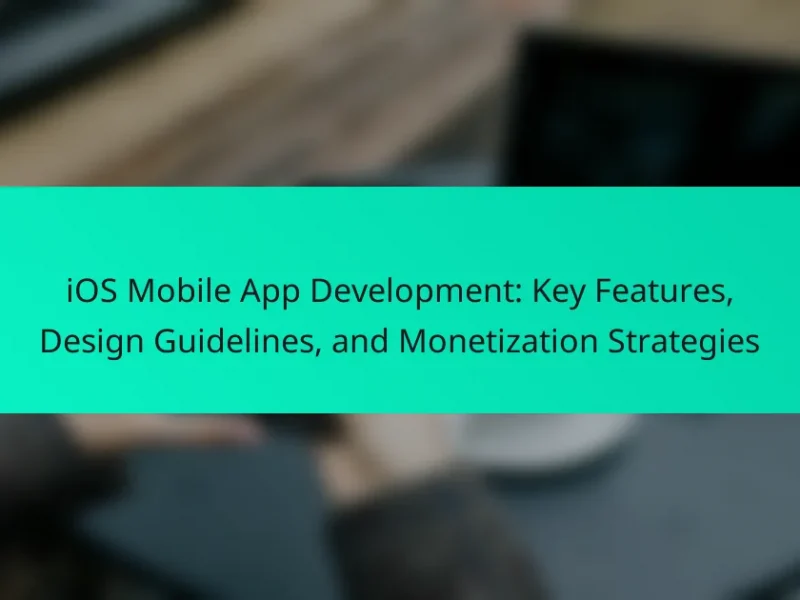Hybrid mobile app development is a method that integrates native and web application elements, enabling the creation of apps that function across multiple platforms like iOS and Android from a single codebase. This approach utilizes web technologies such as HTML, CSS, and JavaScript, encapsulated in a native shell to access device features. The article explores the advantages of hybrid app development, including cross-platform compatibility, reduced development time and costs, and the ability to implement faster updates. It also highlights popular frameworks such as React Native, Flutter, Ionic, and Apache Cordova, and examines various use cases across industries, showcasing the versatility and efficiency of hybrid mobile applications.

What is Hybrid Mobile App Development?
Hybrid mobile app development is a method that combines elements of both native and web applications. This approach allows developers to create apps that can run on multiple platforms, such as iOS and Android, using a single codebase. Hybrid apps are built using web technologies like HTML, CSS, and JavaScript. They are then wrapped in a native shell that enables access to device features. This method enhances development efficiency and reduces costs. According to Statista, the global hybrid app development market is projected to grow significantly, indicating its increasing adoption.
How does Hybrid Mobile App Development differ from Native and Web App Development?
Hybrid mobile app development combines elements of both native and web app development. Native apps are built for specific platforms using platform-specific languages, such as Swift for iOS and Java for Android. They offer high performance and access to device features. Web apps are accessed through browsers and are built using standard web technologies like HTML, CSS, and JavaScript. They are platform-independent but lack full access to device features.
Hybrid apps utilize a single codebase to run on multiple platforms. They are built using web technologies but wrapped in a native container. This allows them to be distributed through app stores while retaining some native capabilities. Hybrid apps can be updated easily since they rely on web technologies.
According to a report by Statista, hybrid app development can reduce development time and costs by up to 30% compared to native development. This makes hybrid development a popular choice for businesses aiming to reach multiple platforms efficiently.
What technologies are typically used in Hybrid Mobile App Development?
Hybrid mobile app development typically utilizes technologies such as HTML5, CSS, and JavaScript. These core web technologies enable developers to create cross-platform applications. Frameworks like Apache Cordova and Ionic are commonly employed to bridge web applications with native device features. React Native is also popular, allowing developers to write in JavaScript while accessing native components. Additionally, Flutter, using the Dart language, is gaining traction for hybrid app development. These technologies facilitate faster development and easier maintenance. They enable a single codebase to run on multiple platforms, reducing time and cost.
How do performance and user experience compare in Hybrid apps versus other types?
Hybrid apps generally exhibit lower performance compared to native apps. Native apps leverage device-specific APIs, resulting in faster execution. In contrast, hybrid apps rely on web technologies, which can introduce latency. User experience in hybrid apps can also be less optimal due to inconsistent UI elements. Native apps provide a more fluid experience by utilizing platform-specific design guidelines. Performance benchmarks indicate that native apps typically load faster and handle complex tasks better. According to a study by Appcelerator, native apps perform 5-10 times faster than hybrid apps in processing speed. This disparity affects user satisfaction and engagement, as users prefer seamless interactions.
What are the key features of Hybrid Mobile Apps?
Hybrid mobile apps combine elements of both native and web applications. They are built using web technologies like HTML, CSS, and JavaScript. These apps run inside a native container, allowing access to device features. Hybrid apps are cross-platform, meaning they can operate on multiple operating systems. They typically offer a single codebase for easier maintenance. Performance can be improved through native plugins. They also provide offline capabilities by storing data locally. Additionally, hybrid apps can be distributed through app stores, increasing visibility and accessibility.
What platforms do Hybrid Mobile Apps support?
Hybrid mobile apps support multiple platforms, primarily iOS and Android. They are designed to run on both operating systems using a single codebase. This capability allows developers to create applications that function seamlessly across different devices. Frameworks like Ionic, React Native, and Flutter facilitate this cross-platform functionality. According to a report by Statista, as of 2023, Android holds approximately 72% of the global mobile operating system market share, while iOS accounts for about 27%. This makes hybrid apps an efficient choice for reaching a wide audience on both platforms.
How do Hybrid Mobile Apps leverage web technologies?
Hybrid mobile apps leverage web technologies by using HTML, CSS, and JavaScript to create cross-platform applications. These technologies allow developers to build a single codebase that runs on multiple operating systems. Hybrid apps use a WebView component to render web content within a native application shell. This approach enables access to device features like GPS and camera through APIs. The use of frameworks such as Apache Cordova and Ionic enhances this capability by providing a bridge between web technologies and native functionalities. Consequently, hybrid apps offer faster development cycles and reduced costs compared to fully native apps. According to Statista, in 2021, hybrid app development accounted for 28% of mobile app development, highlighting its growing popularity in the industry.
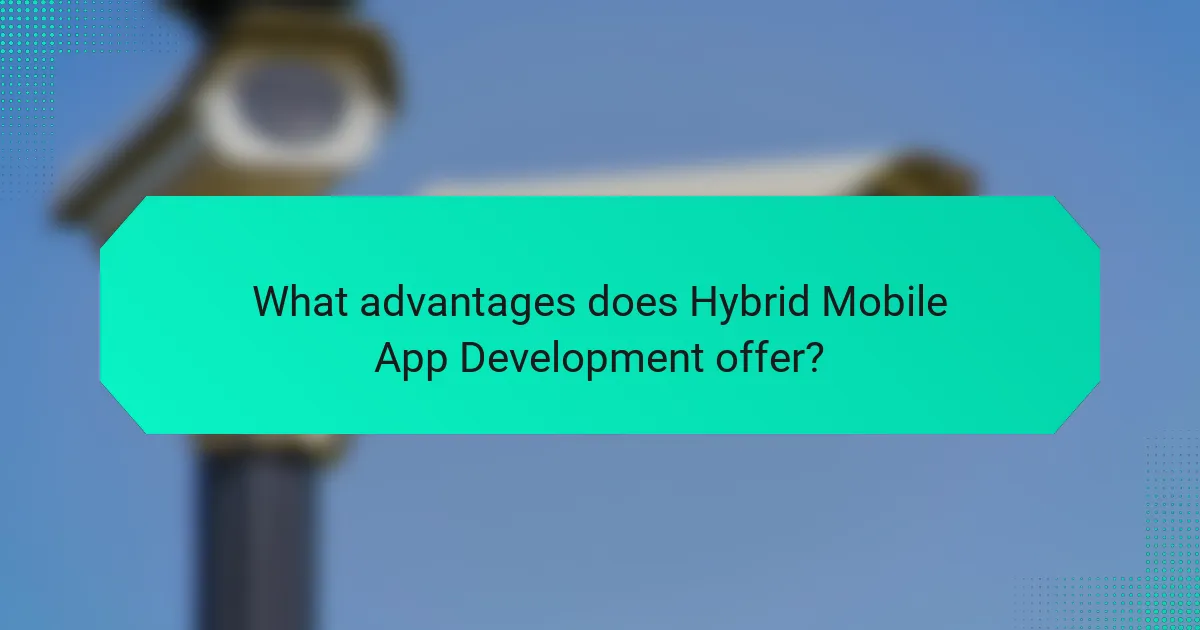
What advantages does Hybrid Mobile App Development offer?
Hybrid mobile app development offers several advantages. It enables cross-platform compatibility, allowing apps to run on both iOS and Android with a single codebase. This significantly reduces development time and costs. Developers can use web technologies like HTML, CSS, and JavaScript, which are widely known. Hybrid apps can access device features such as GPS and camera, enhancing functionality. They also provide faster updates since changes can be made in one codebase rather than multiple platforms. According to a report by Statista, 42% of developers prefer hybrid apps due to these benefits. Overall, hybrid mobile app development streamlines the process and improves efficiency.
How does Hybrid Mobile App Development reduce time-to-market?
Hybrid mobile app development reduces time-to-market by allowing developers to create a single codebase for multiple platforms. This approach eliminates the need to build separate applications for iOS and Android. Developers can write code once and deploy it across various devices. This significantly cuts down on development time and resources. Frameworks like React Native and Flutter streamline this process further. They provide pre-built components and libraries that accelerate development. As a result, businesses can launch their apps faster. Faster launches can lead to quicker user feedback and iterative improvements. This agility in development is crucial in today’s competitive market.
What role does code reusability play in speeding up development?
Code reusability significantly speeds up development by allowing developers to use existing code for new projects. This practice reduces the need to write new code from scratch. Consequently, it minimizes development time and effort. Studies show that code reusability can cut development time by up to 30%. Additionally, it enhances consistency across applications, as reused code maintains the same functionality. This leads to fewer bugs and easier maintenance. Overall, code reusability is a key factor in efficient software development processes.
How does Hybrid Mobile App Development lower development costs?
Hybrid mobile app development lowers development costs by allowing a single codebase to be used across multiple platforms. This approach eliminates the need for separate development teams for iOS and Android. Consequently, companies can save on labor costs and reduce project timelines. According to a study by Statista, hybrid apps can cut development costs by up to 30%. Additionally, maintenance costs are lower since updates can be made to one codebase rather than multiple. This efficiency leads to a faster return on investment for businesses.
What are the scalability benefits of Hybrid Mobile Apps?
Hybrid mobile apps offer significant scalability benefits. They allow developers to write code once and deploy it across multiple platforms. This reduces development time and costs. Additionally, hybrid apps can easily integrate with various APIs and plugins. This flexibility enhances functionality without extensive rewrites. The use of web technologies facilitates easier updates and maintenance. Consequently, businesses can adapt quickly to changing market demands. Studies show that hybrid apps can achieve a broader audience reach, enhancing user engagement.
How do Hybrid apps adapt to different screen sizes and devices?
Hybrid apps adapt to different screen sizes and devices using responsive design techniques. These techniques include flexible layouts, scalable images, and CSS media queries. Hybrid apps leverage frameworks like Bootstrap or Ionic to ensure compatibility across various resolutions. They dynamically adjust UI elements based on the device’s screen size. This adaptability enhances user experience on smartphones, tablets, and desktops. Additionally, hybrid apps utilize viewport settings to control layout rendering. This ensures content displays correctly on any device. Overall, hybrid apps effectively cater to diverse devices by employing these adaptive strategies.
What is the impact of Hybrid Mobile App Development on maintenance and updates?
Hybrid mobile app development significantly reduces maintenance and update efforts. This approach allows developers to write code once and deploy it across multiple platforms. Consequently, updates can be implemented simultaneously for both iOS and Android. This unified codebase simplifies the process, leading to lower costs and faster turnaround times. According to a report by Statista, hybrid apps can be updated 30% more efficiently compared to native apps. This efficiency stems from the ability to address bugs and add features without needing separate updates for each platform. Overall, hybrid development enhances the maintenance lifecycle, making it more streamlined and cost-effective.
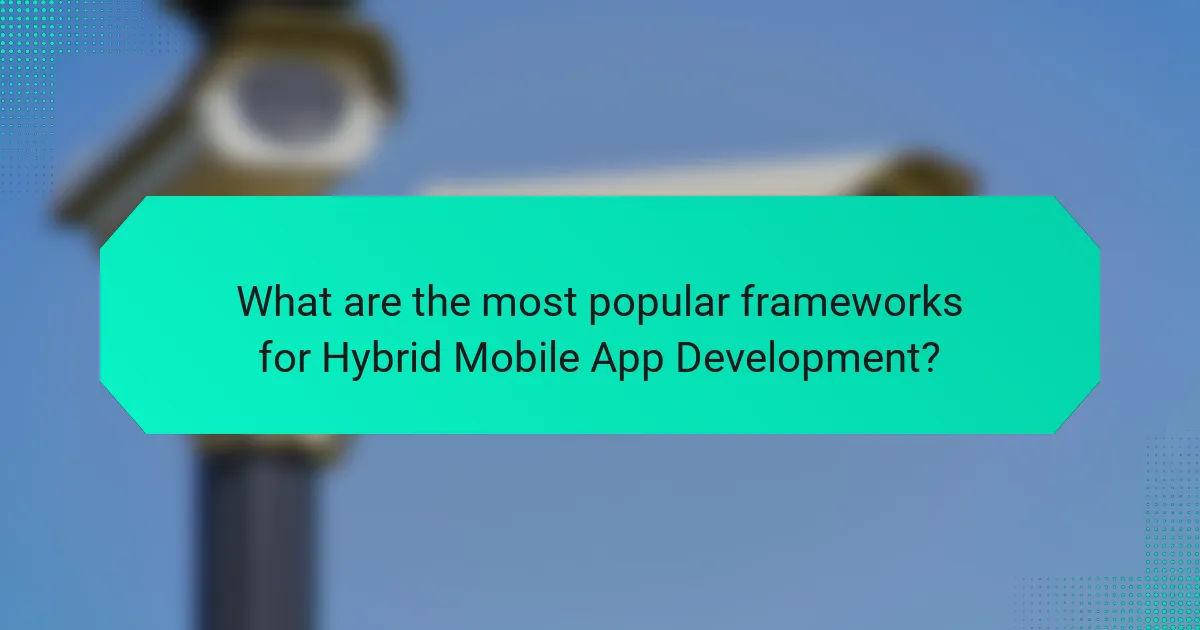
What are the most popular frameworks for Hybrid Mobile App Development?
The most popular frameworks for Hybrid Mobile App Development include React Native, Flutter, Ionic, and Apache Cordova. React Native allows developers to build mobile apps using JavaScript and React. It provides a native-like experience and is widely adopted by companies like Facebook and Instagram. Flutter, developed by Google, uses Dart language and offers fast performance and a rich set of widgets. Ionic focuses on web technologies like HTML, CSS, and JavaScript, making it accessible for web developers. Apache Cordova enables the use of HTML5, CSS3, and JavaScript to create cross-platform apps. These frameworks are popular due to their efficiency, community support, and ability to create high-quality mobile applications.
What are the key features of React Native?
React Native is a popular framework for building mobile applications using JavaScript and React. It allows developers to create cross-platform apps with a single codebase. One key feature is its ability to render native components, which enhances performance and user experience. Another feature is the hot reloading capability, enabling developers to see changes in real-time without recompiling the entire app. React Native also supports third-party plugins, allowing for greater flexibility and functionality. Additionally, it has a large community and extensive libraries, which facilitate faster development and problem-solving. The framework is backed by Facebook, ensuring ongoing support and updates. These features collectively make React Native a powerful choice for hybrid mobile app development.
How does React Native enhance performance in Hybrid apps?
React Native enhances performance in hybrid apps through its use of native components. It allows developers to write code in JavaScript while leveraging native APIs. This results in smoother animations and quicker load times. React Native employs a bridge to communicate between JavaScript and native code. This bridge helps in executing tasks efficiently. Additionally, it supports asynchronous operations, which improves responsiveness. The framework also optimizes rendering by using a virtual DOM. This minimizes the number of updates required to the actual UI. Overall, these features contribute to a better user experience in hybrid applications.
What are the advantages of using React Native for cross-platform development?
React Native offers several advantages for cross-platform development. It enables developers to write code once and deploy it on both iOS and Android platforms. This significantly reduces development time and costs. React Native utilizes a single codebase, which simplifies maintenance and updates. The framework provides a rich set of pre-built components, speeding up the development process. Additionally, it allows for hot reloading, enabling developers to see changes instantly without recompiling the entire app. React Native also has strong community support, ensuring access to a wealth of resources and third-party libraries. Furthermore, apps built with React Native often have performance comparable to native apps due to its native rendering capabilities.
What makes Flutter a popular choice for Hybrid Mobile App Development?
Flutter is a popular choice for hybrid mobile app development due to its fast development cycle and expressive UI. It allows developers to write code once and deploy it on both iOS and Android platforms. Flutter’s hot reload feature enables real-time updates, enhancing productivity. The framework uses a single codebase, reducing maintenance efforts. Additionally, Flutter provides a rich set of pre-designed widgets, which streamline the UI design process. According to a survey by Stack Overflow, Flutter is favored by developers for its performance and ease of use. Its strong community support further contributes to its popularity in the development ecosystem.
What unique features does Flutter offer for developers?
Flutter offers developers unique features such as a single codebase for multiple platforms. This allows for efficient development across iOS, Android, and web applications. Flutter’s hot reload feature enables real-time updates during development. This significantly speeds up the debugging process and enhances productivity. The framework utilizes a rich set of pre-designed widgets that ensure a customizable and visually appealing UI. Flutter also provides high performance through its compiled code, which runs natively on devices. Its strong community support and extensive documentation further empower developers. Additionally, Flutter supports integration with various backend services, enhancing its versatility.
How does Flutter’s widget system improve UI design?
Flutter’s widget system enhances UI design by providing a rich set of customizable components. Each widget in Flutter represents a part of the user interface. This modular approach allows developers to build intricate UIs by composing simple widgets. Flutter’s hot reload feature enables real-time updates during development. This speeds up the design process and allows for immediate visual feedback. Furthermore, Flutter’s widgets are built with a consistent design language, ensuring a cohesive look and feel. The framework supports both Material Design and Cupertino styles, catering to different platform aesthetics. Overall, Flutter’s widget system streamlines UI design, making it efficient and flexible for developers.
What are some other notable frameworks for Hybrid Mobile App Development?
Notable frameworks for hybrid mobile app development include Ionic, React Native, and Flutter. Ionic is known for its ease of use and extensive library of pre-built components. React Native allows developers to write applications using JavaScript and provides a native look and feel. Flutter, developed by Google, offers a rich set of widgets and high performance due to its compiled nature. Other frameworks like Apache Cordova and Xamarin also contribute to the hybrid app landscape. Each framework has unique strengths tailored for different development needs.
What benefits do Ionic and Cordova provide for developers?
Ionic and Cordova provide developers with frameworks that simplify hybrid mobile app development. They allow developers to create cross-platform applications using web technologies like HTML, CSS, and JavaScript. This significantly reduces development time and costs. Ionic offers a rich library of pre-built UI components, enhancing the user experience. Cordova enables access to native device features, such as the camera and GPS, through JavaScript APIs. This integration allows for a more seamless app experience. Both frameworks support rapid prototyping and iterative design. They also benefit from a large community and extensive documentation, which aids in troubleshooting and learning.
How do Xamarin and PhoneGap compare in terms of features and usability?
Xamarin and PhoneGap differ significantly in features and usability. Xamarin provides a rich set of tools and libraries for building cross-platform applications using C#. It allows developers to create native user interfaces and access device APIs directly. PhoneGap, on the other hand, focuses on web technologies like HTML, CSS, and JavaScript. It enables developers to create mobile applications using a single codebase but may not deliver the same level of native performance.
In terms of usability, Xamarin’s integration with Visual Studio offers a robust development environment. This can enhance productivity for developers familiar with Microsoft tools. PhoneGap is generally easier for web developers to adopt, as it leverages familiar web technologies. However, it may offer limited performance compared to Xamarin’s native capabilities.
Overall, Xamarin is better suited for applications requiring high performance and native-like experiences. PhoneGap is ideal for simpler applications that prioritize rapid development and ease of use.
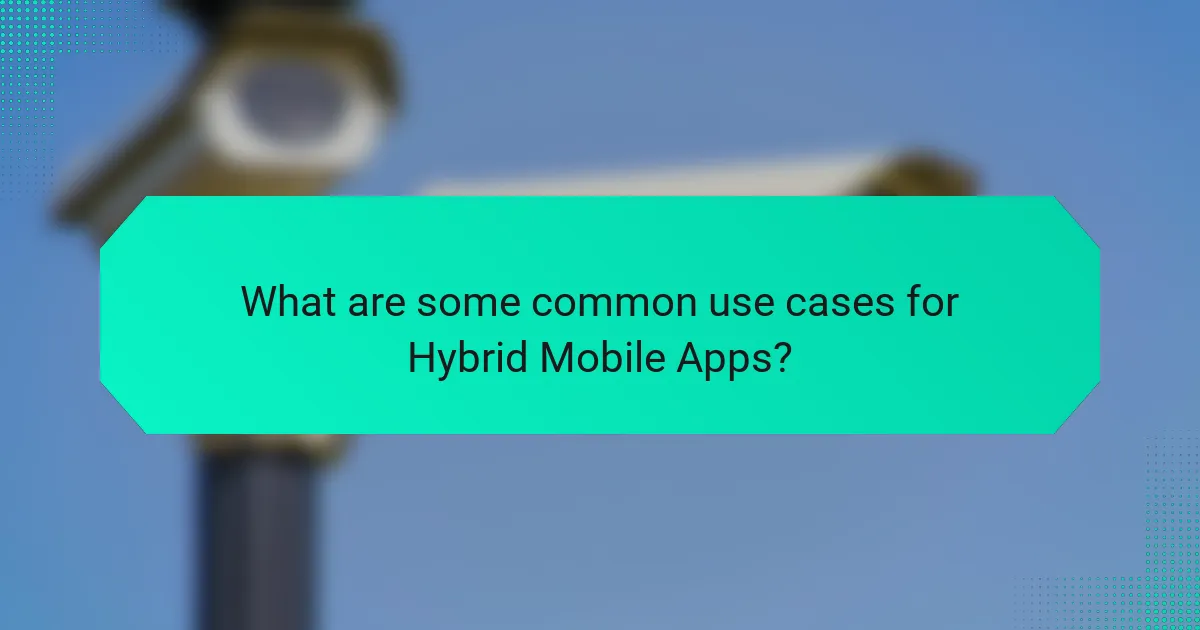
What are some common use cases for Hybrid Mobile Apps?
Hybrid mobile apps are commonly used for various applications across different industries. They are suitable for e-commerce platforms, providing users with a seamless shopping experience. Social media applications often utilize hybrid technology for cross-platform functionality. Educational tools leverage hybrid apps to deliver interactive learning experiences. Business applications benefit from hybrid apps for internal communication and project management. Travel and booking services use hybrid apps for easy access to reservations and itineraries. Health and fitness apps utilize hybrid technology to track user progress and offer personalized plans. These use cases highlight the versatility and efficiency of hybrid mobile apps in meeting diverse user needs.
How are Hybrid Mobile Apps utilized in e-commerce?
Hybrid mobile apps are utilized in e-commerce to provide a seamless shopping experience across multiple platforms. They combine the features of both native and web applications, allowing for faster development and deployment. E-commerce businesses can reach a wider audience by leveraging hybrid apps, as they work on both iOS and Android devices. These apps enable easy integration with payment gateways, enhancing transaction security and user convenience. Additionally, hybrid apps support offline functionality, allowing users to browse products even without internet access. This capability can lead to increased sales and customer engagement. According to a study by Statista, mobile e-commerce sales are projected to reach $3.5 trillion by 2021, highlighting the importance of mobile app strategies in e-commerce.
What features do Hybrid apps provide to enhance the shopping experience?
Hybrid apps provide features that enhance the shopping experience through seamless integration of online and offline capabilities. They offer cross-platform compatibility, allowing users to access the app on various devices. Hybrid apps utilize device features like GPS and camera for personalized shopping experiences. They enable push notifications to inform users about sales and promotions in real-time. Hybrid apps support offline functionality, allowing users to browse products without an internet connection. They also provide a consistent user interface across platforms, improving usability. Analytics integration helps retailers understand consumer behavior better. These features collectively create a more engaging and efficient shopping experience for users.
How do Hybrid apps support payment processing and security?
Hybrid apps support payment processing and security through integration with various payment gateways and secure data handling practices. They utilize APIs to connect with payment processors like PayPal and Stripe. This enables transactions to be processed smoothly within the app. Hybrid apps also implement encryption protocols to protect sensitive data during transactions. SSL (Secure Socket Layer) is commonly used to secure the communication between the app and the payment gateway. Furthermore, they often adhere to PCI DSS (Payment Card Industry Data Security Standard) compliance. This ensures that user payment information is handled securely. By leveraging these technologies, hybrid apps provide a secure environment for financial transactions.
What role do Hybrid Mobile Apps play in social networking?
Hybrid mobile apps facilitate social networking by combining the advantages of web and native applications. They allow users to access social platforms seamlessly across various devices. These apps enable real-time communication and interaction through features like messaging and notifications. Hybrid apps leverage device capabilities, enhancing user engagement with multimedia content. According to a report by Statista, mobile apps account for over 90% of social media time spent by users. This highlights the importance of hybrid apps in providing a smooth user experience in social networking. Their cross-platform compatibility ensures wider reach, connecting diverse user bases.
How do Hybrid apps facilitate user engagement and interaction?
Hybrid apps facilitate user engagement and interaction by combining web and native app features. They offer responsive design, ensuring a consistent experience across devices. This adaptability increases user satisfaction and retention. Hybrid apps utilize device capabilities like GPS and camera, enhancing functionality. They also support push notifications, keeping users informed and engaged. Additionally, these apps can be updated easily without requiring full downloads, maintaining user interest. According to Statista, hybrid apps account for 30% of mobile applications, showcasing their popularity and effectiveness in user engagement.
What unique functionalities do Hybrid apps offer for social media platforms?
Hybrid apps offer unique functionalities for social media platforms, including cross-platform compatibility and access to device features. They allow developers to create a single codebase that runs on multiple operating systems. This reduces development time and costs significantly. Hybrid apps can also utilize native device features like the camera and GPS, enhancing user engagement. Additionally, they support real-time updates, enabling instant content sharing and notifications. These functionalities are crucial for social media platforms to maintain user interaction and provide seamless experiences.
What industries benefit most from Hybrid Mobile App Development?
The industries that benefit most from Hybrid Mobile App Development include retail, healthcare, finance, and education. Retailers utilize hybrid apps to enhance customer engagement and streamline shopping experiences. Healthcare providers leverage hybrid apps for patient management and telemedicine services. The finance sector uses hybrid apps for mobile banking and secure transactions. Educational institutions adopt hybrid apps to facilitate e-learning and student engagement. These industries benefit from the cost-effectiveness and cross-platform capabilities of hybrid app development. According to a report by Statista, the global hybrid app market is projected to grow significantly, indicating increased adoption across various sectors.
How do healthcare and education sectors leverage Hybrid apps?
Healthcare and education sectors leverage hybrid apps to enhance service delivery and improve user engagement. In healthcare, hybrid apps facilitate telemedicine, allowing patients to consult doctors remotely. They also enable secure access to medical records and health tracking features. For instance, apps like MyChart provide patients with real-time updates on their health status.
In education, hybrid apps support e-learning platforms, enabling students to access course materials anytime, anywhere. They often include interactive features like quizzes and forums to enhance learning experiences. For example, apps like Moodle allow educators to create a dynamic learning environment with easy content updates.
Both sectors benefit from hybrid apps’ cost-effectiveness and faster development times. They allow for cross-platform functionality, ensuring wider accessibility for users on different devices. As a result, organizations can reach more users without the need for separate native apps for each platform.
What specific needs do Hybrid apps address in the travel and tourism industry?
Hybrid apps address the need for cross-platform compatibility in the travel and tourism industry. They allow businesses to reach a wider audience by functioning on multiple operating systems. This reduces development costs and time compared to creating separate native apps. Hybrid apps also provide offline access to essential features, enhancing user experience during travel. They enable seamless integration with device features like GPS and camera, which are crucial for travel-related functionalities. Additionally, updates can be rolled out easily without requiring users to download new versions. According to a study by Statista, 52% of mobile users prefer apps that work on any device, highlighting the demand for hybrid solutions.
What best practices should developers follow for successful Hybrid Mobile App Development?
Developers should follow several best practices for successful Hybrid Mobile App Development. First, they should choose the right framework based on project requirements. Popular frameworks include React Native and Flutter, known for performance and community support. Second, developers must ensure a responsive design for various screen sizes. This improves user experience across devices. Third, utilizing native device features enhances functionality. Accessing GPS, camera, and notifications can enrich the app’s capabilities. Fourth, optimizing performance is crucial. This includes minimizing load times and reducing app size. Fifth, thorough testing across multiple platforms is essential. This identifies and resolves issues before launch. Lastly, keeping the app updated with the latest technologies ensures longevity and relevance in a competitive market. Following these practices can significantly increase the chances of success in hybrid mobile app development.
Hybrid mobile app development is a method that integrates elements of both native and web applications, enabling the creation of apps that operate on multiple platforms using a single codebase. This article explores the advantages of hybrid app development, including reduced development time and costs, as well as its scalability and cross-platform capabilities. It also highlights popular frameworks such as React Native and Flutter, and discusses various use cases across industries like retail, healthcare, and education. Additionally, best practices for successful hybrid app development are outlined, emphasizing the importance of responsive design and performance optimization.

